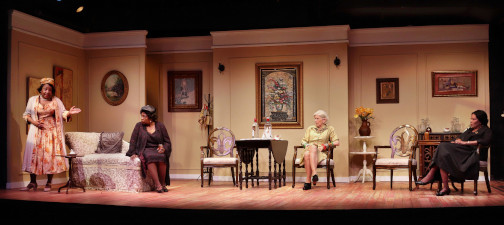
|
Beate Hein Bennett Words Can Slay
This production of “Telling Tales out of School” by Wesley Brown is directed by the legendary Woodie King Jr. the founder of the equally legendary New Federal Theatre with a production history of fifty-three years. It marks a high point in the present re-awakening of the NYC theater scene. The play is based on four historical characters that shaped and shook the literary and artistic scene of the Harlem Renaissance of the 1920s and 30s—a movement that became the foundation for generations of Black writers and artists and was essential to the evolution of 20th century American literature, music, and art. Wesley Brown and Woodie King Jr. are two foundational artists who picked up the challenge in the 1960s to develop and present Black voices who spoke for their generation’s experiences in the struggle to be heard in a white dominant society. (And the struggle continues, as “Black Lives Matter.”) However, Wesley Brown picks up an aspect of the Harlem Renaissance phenomenon that has been largely forgotten: the women writers whose voices contributed significantly to shaping the serious artistic mission of bringing the Black experience into the mainstream of American culture. In his well-researched play we follow four distinct women who meet in June 1954-- for the first time since their heyday in the 20s-- at the memorial service for Alain Locke, one of the “movers and shakers” of the Harlem Renaissance. Three of the women are the writers: Zora Neale Hurston (1891-1960), Nellalitea “Nella” Larsen (1891-1964), Jessie Redmon Fauset (1882-1961). The fourth woman is Nancy Cunard (1896-1965), the British heiress and key figure in the European cultural scene of the 20’s and 30’s who had published a researched book, “Negro: Anthology” with works from Black writers from around the world. Wesley Brown creates an explosive interaction among those four very distinct personalities whose lives had diverged far from their original creative paths. By the 1950s they were shrouded in anonymity, their voices silent or unnoticed. Wesley Brown’s carefully constructed dialogue gives them back their history and their distinct voices: beautiful, rich, powerful, with acerbic humor and the pathos of truthful self-understanding. Under Woodie King, Jr.’s superb, gentle direction the actors bring these historic figures to life with their individual powers of personality, verve, and empathic insight. Richarda Abrams plays Jessie Fauset, now a proud “bourgeois” matron, with the serious authority that she could never quite attain in her position as literary editor of “The Crisis”, the official NAACP paper, because of her conflict with domineering W.E.B.DuBois. Nella Larsen, a highly refined woman, whose writing career was derailed after accusations of plagiarism and despite her highly successful novels “Quicksand” (1928) and “Passing” (1929), became a nurse. Petronia Paley’s subtle portrayal of Nella Larsen as a proud yet delicate woman also reflects the pathos of her solitary life. Elizabeth Van Dyke portrays Zora Neale Hurston. Some years ago in a vivid one-woman performance, she had explored the younger Zora’s many remarkable talents: anthropologist, writer, and performer. Her present performance makes the older Zora shimmer with a funny and sharp humor, a woman deeply hurt but ultimately triumphant over her own fears. June Ballinger plays the fourth member of this quartet, Nancy Cunard, the white privileged “outlier” in this group. Ms. Ballinger gives the character not only mischievous charm but also generosity of spirit that de-tenses the confrontational moments. With self-deprecating irony, Ms. Ballinger moves to poignant jazz interludes that break the scenes as the play delves deeper into the confrontations that expose the psychological traumas suffered by the characters. Mr. Brown structured the play like a string quartet, and Woodie King, Jr.’s direction of the actors’ voices and movements underscores this important dramaturgical aspect. The present production grew out of an NFT workshop production directed by Woodie King, Jr. presented last May at Castillo. It was quite impressive then and now is a beautiful production, enhanced by Chris Cumberbatch’s handsome set design and Gail Cooper Hecht’s elegant costume design that evokes the individual 50’s style of each woman. Antoinette Tynes’ lighting design gives Nancy Cunard’s room in the Hotel Theresa (in Harlem) where the women meet a warm wash of light. Bill Toles has chosen jazz melodies and songs apropos to the mood of the moment. A recording of Paul Robeson’s heart-rending “Going Home” as a prelude to the play sets the perfect mood for what is to come—a kind of going home to life’s ultimate meaning. If you want to find a thought provoking work of theatre, come and listen and watch four wonderful actors “telling tales out of school.”
|
| recordings | coupons | publications | classified |

